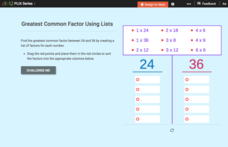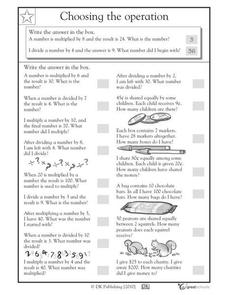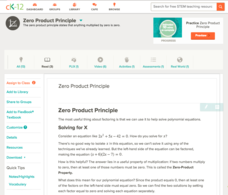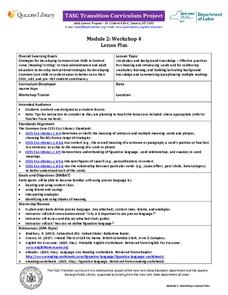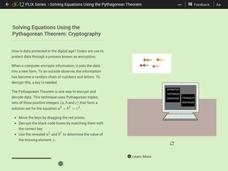DK Publishing
Using the 2 Times Tables
If your third graders have a hard time with multiplication, visualizing the problems might help. Six problems show learners how to count pairs of boxes to solve multiplication with the two times table. At the end, they draw boxes to...
CK-12 Foundation
Greatest Common Factor Using Lists: Tiling the Kitchen Floor
Use a combination of tiling a rectangle to find area and find the greatest common factor of the lengths of two sides and the area they create. Pupils increase and decrease the sides of the rectangle before answer five questions...
CK-12 Foundation
Intercepts by Substitution: Finding a Linear Product Using a Quadratic
Discover another way to interpret multiplication. Using an interactive, learners slide points (representing the factors of multiplication) along the x-axis of the graph of y = x^2 and observe changes in the line segment connecting the...
Curated OER
Simple Use of Parentheses #3
Do your mathematicians know how to use parentheses in equations? Give them a activity to hone their skills in order of operations. They work out 20 simple problems involving parentheses, then choose which problem out of six adds up to a...
West Contra Costa Unified School District
Mixture Problems
Mix up your lessons with the resource on mixture problems. Scholars use manipulatives to model and solve mixture problems. Individuals then set up both one- and two-variable equations to solve the problems.
Los Angeles Valley College
Solving Quadratic Equations Using the Quadratic Formula
Work your way through different quadratic equations with this problem solving resource. The worksheet has twenty problems of different difficulties to get your learners confident in solving these types of problems.
CK-12 Foundation
Greatest Common Factor Using Lists
By creating a list of factors for two numbers, it is easier to see the greatest common factor. Each question in an interactive resource asks pupils to identify the greatest common factor for the numbers 24 and 36 in several...
CK-12 Foundation
Proportions Using Cross-Multiplication: Proportions Using Cross Product
Don't get it crossed—the resource is a great one. Scholars read and watch a video that explains proportions and cross products. They then use an interactive to determine that cross products are equal and answer a set of challenge...
CK-12 Foundation
Alternate Formula for the Area of a Triangle: Alternate Area of a Triangle
It's always nice to have a plan B. Pupils investigate an alternate formula for the area of a triangle that uses sine. A set of challenge questions shows how the new formula relates to the well-known formula of (1/2)bh.
CK-12 Foundation
Standard Form of Linear Equations: Seesaw
Don't hem and haw, learn about equations using a seesaw. An easy-to-use interactive has pupils move a seesaw on a coordinate plane to investigate the standard form of a linear equation. By completing a set of challenge questions, they...
DK Publishing
Multiplying and Dividing by 10, Part 3 - Using the 10 Times Table
Challenge your third graders on the 10 times tables. Given three numbers at the top of each table, learners fill in the missing numbers to complete three more multiplication and division problems. This resource is a great way to extend...
DK Publishing
Tricky Word Problems, Part 2 - Choosing the Operation
Can your learners figure out which equation to solve? Use this resource to challenge your third graders with word problems involving the four operations. Each problem has a section to write the answer, but pupils will need to write out...
CK-12 Foundation
Properties of Equality and Congruence: Justifying Algebraic Steps
No need to justify using this resource. Learners drag justifications for each step of solving an equation in an interactive. To see if they are correct, all they need to do is use a slider and the correct answers appear.
CK-12 Foundation
When to Use the Distributive Property: Rational Expressions
Discover how the distributive property applies to division. As learners change numeric values within an expression, the simulation calculates its value. Challenge questions lead individuals to realize the power of distributing the...
CK-12 Foundation
Existence: One-to-One Functions and Inverses
One-to-one means the answer is simple, right? Given four graphs, pupils use a vertical line to test each graph to find out if they are one-to-one. By using the resource, learners realize that not all one-to-one relations are functions....
CK-12 Foundation
Zero Product Principle
Some lessons feature videos, some interactive practice problems, and some have notes and activities. This comprehensive look at factoring and solving polynomial equations using the zero product principle has all of this and more. Though...
New York State Education Department
TASC Transition Curriculum: Workshop 4
Why is it important to use precise language? Participants explore this question in the fourth activity in a series of 15 on effective instruction. Perfect for all content areas, the activity promotes appropriate language choice through...
CK-12 Foundation
Solving Equations Using the Pythagorean Theorem: Cryptography
Don't keep this resource a secret. Individuals learn to use the Pythagorean Theorem to find Pythagorean triples. They also see how Pythagorean triples can be useful in the field of cryptography to encrypt secret messages.
CK-12 Foundation
Applications Using Linear Models: Scuba Diving
Dive into this resource on rates of change and linear models. Pupils use two sliders in an interactive to adjust water temperature and depth. They use a given linear equation to calculate the rate of change in water temperature per unit...
Curated OER
Real-life Problems, Working with Decimals
Put your learners' decimal skills to the test with these five word problems. With space for students to write their work, the word problems contain addition and multiplication problems with money and measurement units. Use this resource...
DK Publishing
Numbers 1 to 20
Practice writing numbers with fun kites. Kindergartners will rise to the highest height as they match the numbers to their correct written forms: 11 to eleven, 14 to fourteen, etc. Use this resource as a class activity or as a review...
Curated OER
Subtracting Decimals
How well can your fifth graders work with decimals? What about subtracting decimals? Use this resource to practice these important skills. Sixteen problems help pupils subtract decimals to the hundredths place, while 10 problems at the...
Curated OER
Writing Numbers
A multi-faceted approach to place value! Third graders write four-digit numbers, as well as interpreting the written forms of large numbers. Use the resource as a unit assessment, or in parts as a warm-up activity throughout the week.
EngageNY
Estimating Probability Distributions Empirically 2
Develop probability distributions from simulations. Young mathematicians use simulations to collect data. They use the data to draw graphs of probability distributions for the random variable in question.






